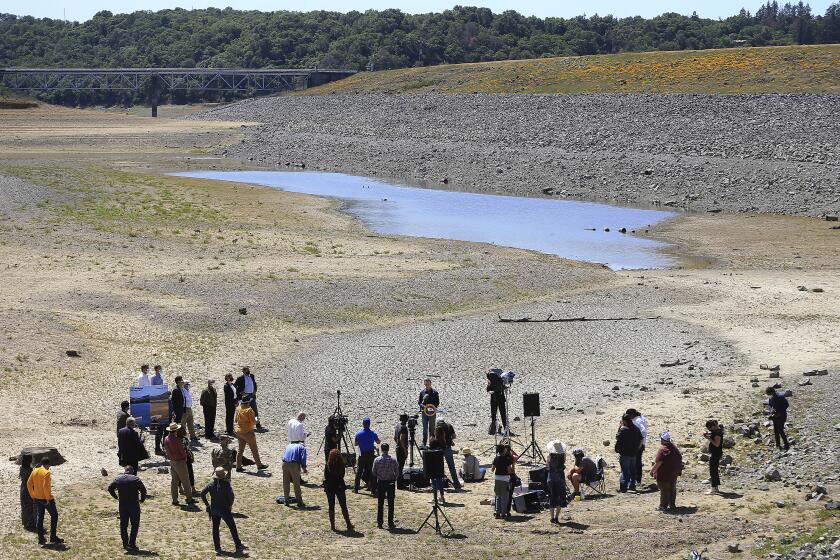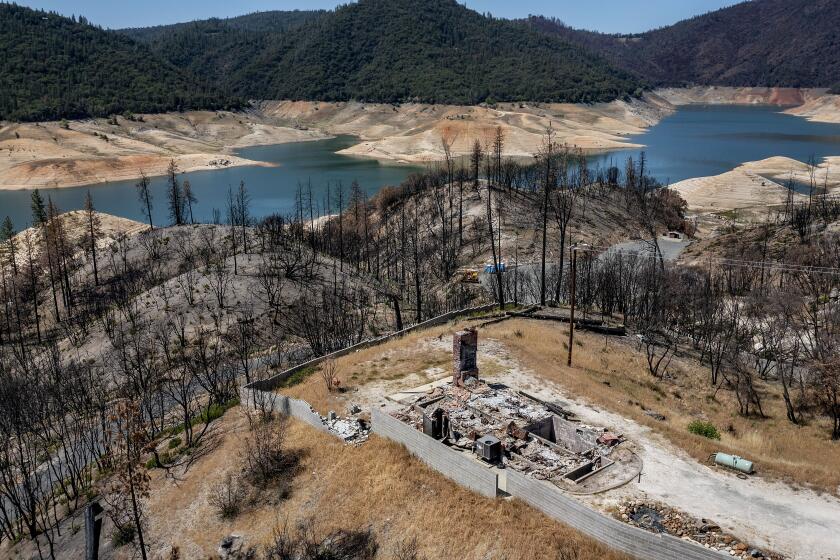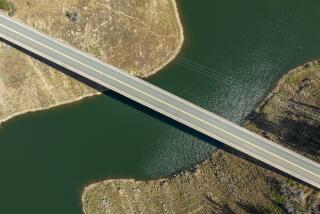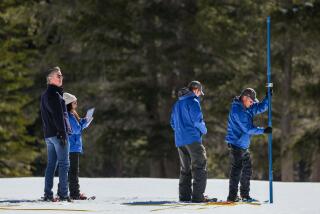Newsom asks all Californians to voluntarily reduce water usage by 15% amid drought

Gov. Gavin Newsom on Thursday expanded his regional drought state of emergency to apply to 50 California counties, or roughly 42% of the state’s population.
- Share via
SACRAMENTO — Gov. Gavin Newsom is asking Californians to voluntarily cut back on water consumption by 15% compared with last year as drought conditions worsen and temperatures continue to rise across the western United States.
The governor on Thursday also expanded his regional drought state of emergency to apply to 50 California counties, or roughly 42% of the state’s population.
“We’re hopeful that people will take that mindset they brought into the last drought and extend that forward with a 15% voluntary reduction, not only on residences but industrial commercial operations and agricultural operations,” Newsom said at a news conference in San Luis Obispo County.
With the recall election two months away, the governor has refrained from issuing a state of emergency for all of California or mandating water restrictions as drought covers the state.
Standing before Lopez Lake, where the reservoir is at less than 35% capacity, Newsom encouraged people to take “common sense” measures, such as watering lawns less, fixing water leaks on their properties and taking shorter showers. He underscored that water reductions are not required.
California isn’t being a “nanny state,” he said.
“We’re not trying to be oppressive,” Newsom said. “Again, these are voluntary standards.”
Gov. Gavin Newsom on Thursday asked everyone to do their part to save water amid a worsening drought. Here are the basics.
The governor and his aides have pushed back on the need for more drastic action, saying water resources vary in different parts of the state and not all 58 counties are in an emergency situation.
Newsom’s regional emergency order instead provides a path for the State Water Resources Control Board to mandate potentially unpopular water restrictions. The declaration also makes it easier for counties to coordinate water supply with the state and reduces some environmental regulations.
The state water board issued curtailment notices to water rights holders in the Russian River watershed earlier this month, and has warned rights holders of water unavailability in the Scott River Basin, Sacramento-San Joaquin Delta watershed and other areas in light of dwindling supplies.
State leaders in climate change and water resources warn that California’s drought is already causing dire conditions for people, plants, animals and land.
Sen. Andreas Borgeas (R-Fresno) said Newsom needs to go further than voluntary reductions and regional orders. He said the governor should direct state agencies to prioritize water supplies for drinking water and food production over environmental considerations in the short term, and invest money to improve water storage in California in the future.
California was at a crisis stage months ago and it’s likely to get worse in the years to come, he said.
“This is a crisis of epic proportions,” Borgeas said. “The problem is we don’t have any water storage that is going to change the trajectory.”
From a political perspective, water restrictions present a damned if you do, damned if you don’t situation for Newsom, said Steve Maviglio, a Democratic political consultant who served as press secretary for former Gov. Gray Davis.
“The American lawn is sacrosanct, so anytime somebody tells you that you can’t keep it green, there’s going to be pushback, and we’ve seen that before,” Maviglio said.
Proponents of the recall have already attempted to tie Newsom to the issue of water restrictions. The official petition they circulated to gain enough signatures to force an election listed “rationing our water use” as one of the many “burdens” the governor sought to impose on the state.
Maviglio said it makes sense for Newsom to ask Californians to voluntarily reduce their water consumption before ordering them to do so. But he also runs the risk of being criticized later for acting too slowly, Maviglio noted, considering the drought didn’t happen overnight and the state has known about the problem for some time.
“It’s another one of these issues where he has to tread very carefully because it could hurt him no matter what he does, and that’s the danger of the recall climate,” Maviglio said.
California is in the midst of a particularly dry year, due to below-average precipitation and low snowpack in the Sierra Nevada.
Newsom added Inyo, Marin, Mono, San Mateo, Santa Barbara, Monterey, San Luis Obispo, Santa Clara and Santa Cruz counties to his regional emergency order on Thursday. The governor’s original order on April 21 applied to Mendocino and Sonoma counties before he added another 39 counties on May 10.
Southern California appears to be in better shape than other areas. Imperial, Los Angeles, Orange, Riverside, San Bernardino, San Diego, San Francisco and Ventura are the only counties not under a regional drought state of emergency at this time.
Officials from the Metropolitan Water District of Southern California, which imports water from the Colorado River and the north, say there are record reserves in regional reservoirs and groundwater banks — enough to carry the district through 2022. Los Angeles, which is partly supplied by the MWD, also doesn’t anticipate any shortages, officials said last month.
Some local communities have stepped up their own household water conservation rules, and officials expect more urban restrictions in certain parts of the state.
If achieved, a voluntary 15% water reduction statewide would save roughly 850,000 acre-feet of water, which is enough to supply 1.7 million households for a year, according to the governor’s office.
Newsom said the State Water Resources Control Board and the Department of Water Resources will track progress toward the voluntarily 15% reduction and decide whether further measures are necessary.
During the last drought, per capita residential water use dropped 21% between 2013 and 2016 and remains 16% below 2013 levels today, the governor’s office said.
On Thursday, the governor also drew attention to the long-standing Save Our Water campaign, started in 2009 by the Assn. of California Water Agencies and the California Department of Water Resources to encourage water conservation, for tips on how to reduce usage.
More to Read
Sign up for Essential California
The most important California stories and recommendations in your inbox every morning.
You may occasionally receive promotional content from the Los Angeles Times.













